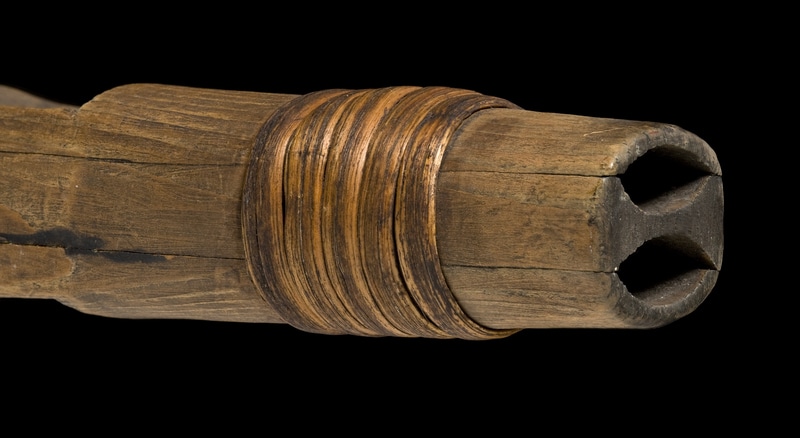Musical Instrument Item Number: 1921.24.32 from the Pitt Rivers Museum


Description
Wooden double whistle bound with cedar bark. [CAK 04/06/2009]
Longer Description
Wooden double whistle bound with cedar bark. Carved from a single piece of wood, the flute is comprised of three sections that run the length of the flute and have been re-affixed with a resin(?) and bound with cedar bark in three places. The flute is narrowest at its mouthpiece and then widens towards its end. There are two windways extending from the mouthpieces, one of the top of the flute and one on the bottom. The windways do not extend the length of the flute; instead they end just after the labia. There are no finger holes. One labium has been carved on the top, and one on the bottom of the flute. Between the mouthpiece and labia, a strip of cedar bark has been wrapped around the flute five times, and below the labia thinner strips of cedar bind the flute in two places. A black substance is visible on the sides of the flute where the sections join together. [CAK 04/06/2009]
Research Notes
The following information comes from Haida delegates who worked with the museum's collection in September 2009 as part of the project “Haida Material Culture in British Museums: Generating New Forms of Knowledge”:
This whistle was viewed alongside other musical instruments on Thursday Sept 10, 2009. Delegates identified this as a flute used in ceremonies by secret societies. Vernon Williams commented that usually this kind of whistle needs to be soaked in water to allow the wood to swell before they will make a sound. Vern tried this whistle and produced a high-pitched sound. Today, glue is used to create a sealed airway, rather than soaking. It was suspected that the whistle would produce an even higher pitch if it were soaked. Christian White identified the wood as red cedar, with cedar bark used to bind the halves together. Christian noted that whistles of this kind only produce two notes. Diane Brown said that double whistles are not commonly seen. See also notes for 1921.24.31. [CAK 13/05/2010]
Primary Documentation
Accession Book Entry - June 1921. Louis C. G. Clarke, Esq. M.A. - 1921.241, -242 [1 of] 2 wooden double whistles, Haida, Queen Charlotte Island.
Additional Accession Book Entry - Number given HLR.
Card Catalogue Entry - CANADA, QUEEN CHARLOTTE ISLANDS, HAIDA INDIANS Wooden double whistle. Long and narrow, bound in three places with ?creeper, darker wood.
Pre-PRM label - A 361 / # 8913 / 700 [in pencil] Haida [MJD 01/04/2009]
Pitt Rivers Museum label - [Related Documents File] Double whistle. HAIDA, QUEEN CHARLOTTE I. d.d. L. C. G. Clarke 1921. [LKG 26/06/2009]
Pitt Rivers Museum label - [Related Documents File] Double whistle. HAIDA, QUEEN CHARLOTTE I. d.d. G. C. G. Clarke 1921. [LKG 26/06/2009]
Written on object - Double whistle HAIDA, QUEEN CHARLOTTE ID. Pres. by L. C. G. Clarke, 1921 [MJD 01/04/2009]
Related Documents File - The Haida Project Related Documents File contains video of research sessions and interviews with Haida delegates from September 2009 as part of the project ‘Haida Material Culture in British Museums: Generating New Forms of Knowledge'. It also includes post-visit communications that discuss object provenance. For extensive photographic, video, and textual records documenting the Haida research visit as a whole, including but not limited to preparations of objects for handling, travel logistics, British Museum participation, transcribed notes from research sessions and associated public events held at PRM, see the Haida Project Digital Archive, stored with the Accessions Registers. Original hand-written notes taken during research sessions have been accessioned into the Manuscripts collection, in addition to select other materials. [CAK 02/06/2010]
Item History
- Made in Haida Gwaii, British Columbia, Canada
- Collected by Louis Colville Gray Clarke ?
- Owned by Louis Colville Gray Clarke
- Received from Louis Colville Gray Clarke during 1921
What
- Name
- Musical Instrument
- Identification Number
- 1921.24.32
- Type of Item
- musical instrument
- Material
- cedar wood plant and cedar bark
- Manufacturing Technique
- carved, bound, glued ? and split ?
- Overall
- width 35.0 mm
Who
- Culture
- Haida
- Field Collector
- Louis Colville Gray Clarke ?
- Previous Owner
- Louis Colville Gray Clarke
- Received from
- Louis Colville Gray Clarke
Where
- Holding Institution
- Pitt Rivers Museum
- Made in
- Haida Gwaii, British Columbia, Canada
When
- Acquisition Date
- during 1921
Other
- Keyword
- Musical Instrument; Flute; Ceremonial Object
- Class
- Music; Ceremonial